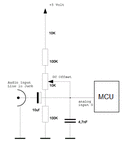rompelstilchen
Full Member level 2
Hello,
I bought this amp
https://www.aliexpress.com/item/Fre...32808014301.html?spm=a2g0s.9042311.0.0.z2nGmn
it uses a PAM8406
"5W Output at 10% THD with a 2Ω Load and 5V Power Supply at Class-D Mode
3W Output at 10% THD with a 4Ω Load and 5V Power Supply"
I have :
8ohms 1W speaker (tried 1 ,then 2 in series, terrible sound)
8ohms (0,4W) tested : crap low sound
16ohms (0.2W) speaker : a bit better sound, but not powerfull
16ohms (1W) speaker : best solution so far, but does not match amp perfectly
is it ok if I dont use a speaker in perfect accordance to the amp specs ? what is the risk ?
thanks
I bought this amp
https://www.aliexpress.com/item/Fre...32808014301.html?spm=a2g0s.9042311.0.0.z2nGmn
it uses a PAM8406
"5W Output at 10% THD with a 2Ω Load and 5V Power Supply at Class-D Mode
3W Output at 10% THD with a 4Ω Load and 5V Power Supply"
I have :
8ohms 1W speaker (tried 1 ,then 2 in series, terrible sound)
8ohms (0,4W) tested : crap low sound
16ohms (0.2W) speaker : a bit better sound, but not powerfull
16ohms (1W) speaker : best solution so far, but does not match amp perfectly
is it ok if I dont use a speaker in perfect accordance to the amp specs ? what is the risk ?
thanks
